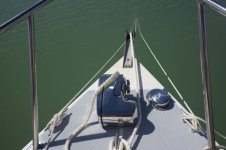ThumbsUp
Member
- Joined
- Jun 23, 2014
- Messages
- 50
- Reaction score
- 0
- C Dory Year
- 2006
- C Dory Model
- 22 Cruiser
- Vessel Name
- Thumbs Up
Hello fellow Cbrats,
I have a few questions relating to the installation of a new V700. I won't be doing the install, but I want to make sure the boat shop I've selected does it properly. I decided to go with a V700 based on suggestions by Thataway - Thank you! Installing Lewmar bow roller compatible with #14 Delta fast set anchor.
#1 Placement of anchor switch - A picture on the Cbrats website shows an installation of an anchor switch close to the forward window (one that opens) so that it's accessible from outside. This seems like a good idea.
#2 Boat shop will core out balsa and reinforce with fiberglass where windlass is installed. How much balsa should be cored out? How deep should they go?
#3 There will not be a direct path between the bow roller and the cleat for the rode. Does the rode wrap around the V700 and tie off to cleat when anchored?
#4 Anchor drain - Port side? Should the hold be drilled above the strake to allow room for the clamshell? Anchor locker will have to be raised with glass to allow for proper drainage.
#5 How much water enters through the windlass/rode hold while underway in rough conditions?
#6 Boat shop suggested installing a new back plate under the factory cleat. All that's there now are large washers.
Any other suggestions on this install would be much appreciated.
Thank you!
:thup
I have a few questions relating to the installation of a new V700. I won't be doing the install, but I want to make sure the boat shop I've selected does it properly. I decided to go with a V700 based on suggestions by Thataway - Thank you! Installing Lewmar bow roller compatible with #14 Delta fast set anchor.
#1 Placement of anchor switch - A picture on the Cbrats website shows an installation of an anchor switch close to the forward window (one that opens) so that it's accessible from outside. This seems like a good idea.
#2 Boat shop will core out balsa and reinforce with fiberglass where windlass is installed. How much balsa should be cored out? How deep should they go?
#3 There will not be a direct path between the bow roller and the cleat for the rode. Does the rode wrap around the V700 and tie off to cleat when anchored?
#4 Anchor drain - Port side? Should the hold be drilled above the strake to allow room for the clamshell? Anchor locker will have to be raised with glass to allow for proper drainage.
#5 How much water enters through the windlass/rode hold while underway in rough conditions?
#6 Boat shop suggested installing a new back plate under the factory cleat. All that's there now are large washers.
Any other suggestions on this install would be much appreciated.
Thank you!
:thup



